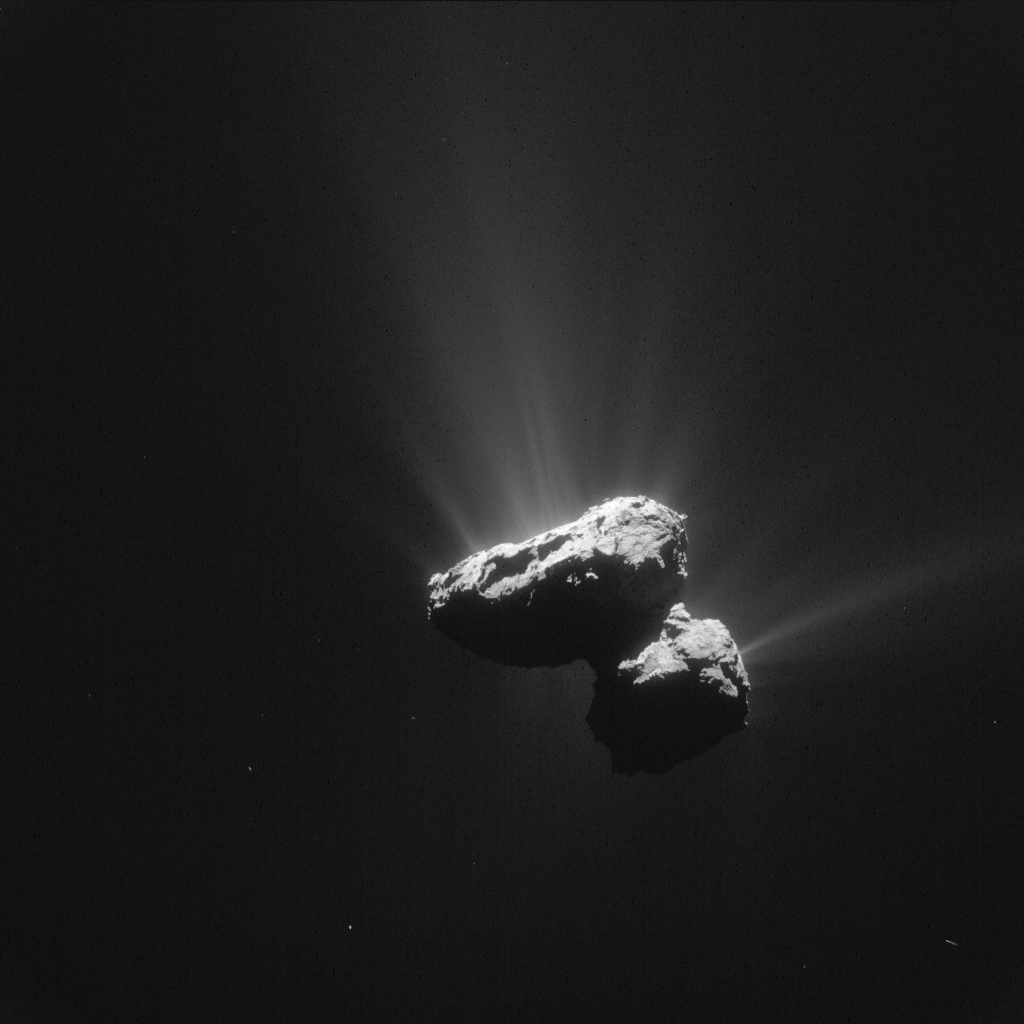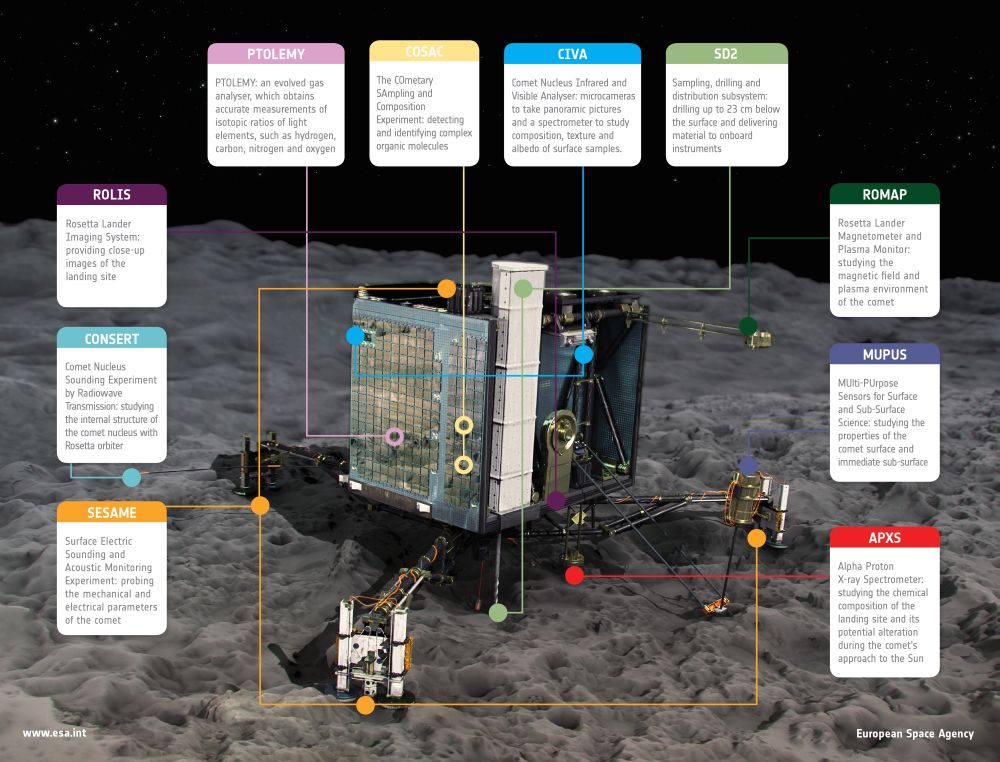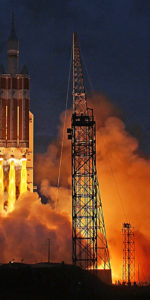
The European Space Agency’s (ESA) Rosetta spacecraft is on the precipice of making more discoveries as its comet begins to “heat up.” Just weeks before Comet 67P/Churyumov-Gerasimenko reaches perihelion—the point where its orbit brings it closest to the Sun—the Rosetta spacecraft has been moved back from the comet due to increasing activity. While the spacecraft will begin an unprecedented observation of a comet during this crucial period, the German Aerospace Center (DLR) continues to troubleshoot Philae’s communication issues. At present time, the lander has not been heard from since July 9.
Waiting for a “Phone Call” from Philae
After a period of seven months in hibernation, Philae “woke up” last month to the world’s surprise and elation. While the lander has made a few brief communications through the Rosetta orbiter, the transmissions have been sporadic and unpredictable at best. The last communication lasted for 12 minutes on July 9, and data from the recently reactivated CONSERT (COmet Nucleus Sounding Experiment by Radiowave Transmission) instrument was relayed back to Earth. According to Philae’s team at DLR, data relayed back during one of the transmissions revealed that sunlight is falling differently on the lander’s solar panels, which may “shed some light” about its position upon the landing site (named “Abydos”). Images relayed back have revealed the region to be surrounded by craggy, cliff-like rock formations.
ESA explained: “The lander is likely situated on uneven terrain, and even a slight change in its position – perhaps triggered by gas emission from the comet – could mean that its antenna position has also now changed with respect to its surroundings. This could have a knock-on effect as to the best position Rosetta needs to be in to establish a connection with the lander.” This explanation makes perfect sense, as the comet’s activity continues to increase as it approaches the Sun. Stephan Ulamec, Philae’s project manager at DLR, stated, “The profile of how strongly the Sun is falling on which panels has changed from June to July, and this does not seem to be explained by the course of the seasons on the comet alone.”
It has also been revealed that one of Philae’s transmission units is not functioning properly; according to ESA, “One of the two receiving units is damaged.” DLR has sent “blind” commands to the lander in order to allow it to work with the one working transmitter. Philae’s team is also making preparations to send commands to the lander in a bid to re-activate scientific operations. ESA reported, “This ‘safe block’ set of activities includes temperature measurements by the thermal probe MUPUS, measurements by ROMAP and SESAME, and analysis by PTOLEMY and COSAC in sniffing mode, and do not involve moving any mechanism on [the] lander.” (The purposes of these instruments are explained in the graphic image below.)

Despite not having heard from the plucky lander in some time, Philae’s team is confident they will hear from it again: “Philae is obviously still functional, because it sends us data, even if it does so at irregular intervals and at surprising times. Several times we were afraid that the lander would remain off – but it has repeatedly taught us otherwise,” Ulamec emphasized. DLR stated in a short video shared on Twitter, “Keep supporting Philae, just like we do.”
As Comet Activity Increases, Rosetta Takes a Step Back
The communication issues with Philae also may stem from Rosetta being forced to “take a step back” from 67P as the comet becomes increasingly more active as it approaches perihelion. ESA stated the orbiter is now 170 to 190 kilometers from the comet, as opposed to its previous distances of 153 to 180 kilometers. Rosetta had been stationed at these distances flying along 67P’s “terminator plane” to optimize communications with Philae. However, according to ESA, dust particles from the “excited” comet impeded the spacecraft’s star tracker, necessitating a move to safer distances.
As perihelion draws closer, the orbiter is busy making its own scientific observations, as the comet’s southern regions have become more visible. Recent images from Rosetta reveal an ethereal world “back-lit” with sunlight, emanating gas jets, cosmic dust, and water vapor. The orbiter is coming up on its one-year anniversary in Comet 67P’s orbit on Aug. 6, while the comet will reach perihelion Aug. 13. While the ESA spacecraft Giotto flew through Comet Halley’s coma (or “tail”) in 1986, this will be the first time an orbiting spacecraft observes a cometary target during perihelion. It is expected that the comet will give Rosetta (and researchers on Earth) an unforgettable anniversary gift: A first-of-its-kind view of a comet at its prime.
This ESA video summarizes Rosetta’s first year of scientific discoveries. Video Credit: ESA on YouTube
Please check back with AmericaSpace for more updates about ESA’s Rosetta mission.
Want to keep up-to-date with all things space? Be sure to “Like” AmericaSpace on Facebook and follow us on Twitter: @AmericaSpace
Missions » Rosetta »




2 Comments
2 Pings & Trackbacks
Pingback:Rosetta ready for perihelion | Off to the Space Races
Pingback:Philae’s First Science Results Highlight an Unexpected Cometary World « AmericaSpace